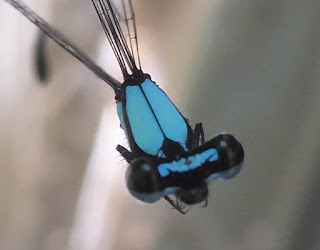*This article was adjusted August 5, 2019, as a result of the publication of a new species
Euphaea cyanopogon Hämäläinen, Kosterin & Kompier, 2019. I retain the original text, but the species
E. pahyapi is distinct differences with the present species, which now has been described as a new species.
On December 30 I was surveying streams in the forest at the northern side of Phu Quoc island when I noticed a smallish
Euphaea species with uniform amber-colored wings. Because
E. ochracea had been reported from the island from previous surveys and one of the reports showed a similar amber-colored winged specimen, for the time being I assumed it was this species. But at home checking it against the few specimens that I possess and many photos, both from myself and on the web, the suspicion rose that this really could not be
E. ochracea. Not only in outward appearance was it different, but also structurally, like the caudal appendages and the vesicula seminalis. When I caught on to the fact that all adult males of species known from Vietnam have a completely dark face, whereas the Phu Quoc species had whitish-blue markings on the labrum and genae, I became convinced it had too be something else,
E. pahyapi. In fact the species was not rare, although also not particularly common, but I saw at least 10 spread over several streams and on January 1 and 2 also noticed it in the forest more centrally to the island.
The species displays some very interesting characteristics. The males I saw (and I only saw males) had facial markings in varying degrees of intensity. A large, but centrally split, spot on the labrum and a large spot on the genae, anteriorly with an incursion of black. The wings were rather straight for the genus and with generally similarly shaped fore wing and hindwing. These were evenly colored from base to apex. Although the discoidal cells of the two specimens I collected are not entire (contra Hamalainen 1985), the cubito-anal space had only 2 cross veins in the fore wing of both specimens and 3 (once 2) in the hindwing, contrary to
O. ochracea, which has mostly 4 (or even 5). This fits the description by Hamalainen of
E. pahyapi. That species, just like my specimens, has a smooth vesicula seminalis, unlike the grooved vesicula of
E. ochracea. The prothorax had vague markings in a few younger specimens, but became all black, contrary to
ochracea, which has obvious place areas, and the thorax pattern also was much reduced and less rufous. The abdomen moreover was much darker than in
ochracea, again fitting
E. pahyapi. The measurements (2 specimens) are an exact fit with those given by Hamalainen for
pahyapi, for abdomen, fore wing and hindwing (31-33mm; 29mm; 27mm). Especially fore wing tends to be longer in
ochracea. And unlike any of the known species from Vietnam, but in line with
E. pahyapi, S3 is adorned with a large area of long hairs. The caudal appendages are rather triangular in outline in lateral view, rather than rectangular.
E. pahyapi was described by Matti Hamalainen in 1985 from peninsular Thailand. Almost immediately afterwards Asahina published
E. khaochongensis, which later was synonymized with
E. pahyapi as a junior synonym. This is of particular interest, because in the description of Hamalainen the face is completely black, but in that by Asahina the labrum, genae and anteclypeus are all described as dirty blue. As almost all characteristics fit
E. pahyapi, it seems quite sufficient to identify it as such. The only obvious difference is the pattern of the face, but given the description of its synonym
E. khaochongensis, this is apparently within the range of variability. The other minor difference is that the discoidal cell in both collected specimens has one or two cross veins in all the wings, not entire as was the tendency for Hamalainen's specimens. Of course DNA analysis or further research may still identify the Phu Quoc population as different from that of the Malay Peninsula, but for now the identity of this species as
E. pahyapi, not
E. ochracea, seems well supported.
IUCN lists E.
pahyapi as vulnerable, known from just 3 locations in Thailand and under threat of habitat destruction. As such, its discovery on Phu Quoc in good numbers is very relevant.
 |
| Male Euphaea pahyapi. Note the wings of almost similar wit and length, uniformly amber in color. This individual still with yellow-brown spots on prothorax and near ocelli. Also note that dorsal stripes are almost obscured and mesepimeron lacking the stripe bordering the humeral suture. |
 |
| Another male, with dorsal stripe completely obscured, antehumeral stripe much diminished and mesepimeron with only a reduced stripe along the interpleural suture. This individual with completely black prothorax and cranium. |
 |
| Close-up of S3 with the mass of long hairs on the proximal half |
 |
| Close-up of the superior caudal appendages, showing their triangular shape, widest close to the base. |
 |
| Close up of the smooth vesicula seminalis (left in the picture) |
 |
| Close-up of facial pattern of one male, with extensive bluish white adjacent to the compound eyes, large bluish-white patches on the genae and on the labrum, and paler brown on the anteclypeus. |
 |
| Another male, in which the markings are much reduced, especially adjacent to the eyes, but also split into two parts now on the labrum. |





























